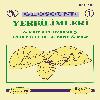Girit yayının sismolojik ve Bouguer Gravite Anomalisi verilerine göre yorumlanması
Doğu Akdeniz Bölgesi'nin neotektoniğini, Afrika Plakası, Arap Plakası ve Avrasya Plakasının göreceli hareketleri denetlemektedir. Bölge, Anadolu Plakasının Kuzey Anadolu Fay Zonu (KAFS) boyunca batıya kaçması ve bu plakanın Yunan Kesme Zonunun etkisi ile Güney- Batı yönlü hareketi ile şekillenmektedir. Girit ada yayı ve buradaki dalma-batma zonu plaka hareketlerinin etkileşim mekanizması ile sürecini günümüzde halen devam ettirmektedir. Dolayısıyla günümüzde devam eden tektonizma özelliklerini ortaya koymak ve bölgeye genel bir tektonik model oluşturmak için 23-28 boylamları / 33-38 enlemleri ile sınırlandırılmış çalışma alanında sismoloji ve gravite verileri irdelenmiştir. Bu amaç doğrultusunda, sismolojik veriler USGS'ten, gravite verileri ise 1971-74 Shakleton çalışmalarından sağlanmıştır. Sismolojik çalışmalarda, USGS' ten 1973-2004 (32Yıllık) yıllarına ait tüm sismolojik ham veri seti elde edilmiştir. Bu veriler Mag 3 şeklinde 6579 adet deprem verisi olarak sınıflandırılmıştır. Daha sonra depremler yıllara, büyüklüklere, derinliklere göre istatistiksel olarak incelenmiştir. Elde edilen bulgular ile Girit adası ve çevresi sismolojik açıdan değerlendirilmiştir. Bölgede baskın olarak, %95.3 oranında büyüklüğü 3-5 arasında, %85.9 oranla da derinliği 0-60 km arasında depremler mevcuttur. Orta derinlikteki depremler (60-200 km) özellikle 24-26 boylamları ile 38-36 enlemleri arasında kalan alanda gözlenmiştir. En derin deprem verisi 180-190 km civarında saptanmıştır. Girit yayının batı ve doğu kanatlarında (23-24 /26-28 boylamları) ise derinliğin bu kadar fazlalaşmadığı, ortalama 100 km civarında kaldığı görülmektedir. Dolayısıyla bu sonucu desteklemek beraberinde ana dalımın modelini ortaya koymak için çok yoğun depremlerin gözlendiği 0-50 km odak derinliklerine ait depremler elimine edilerek 60-200 km arası odak derinlikli depremler 3 boyutlu olarak modellenmiş ve dalımın fiziksel ana görüntüsü ortaya konmuştur. Bir diğer uygulamada, dalımla ilgili ana mekanizmayı ortaya koymak amacıyla yapılan derinlik kesitinde de dalımın 180 km' ye kadar devam ettiği, 100 km civarında bükülmenin olduğu, dalım eğiminin, dalımın ilk kısımda ortalama 30° ikinci kısımda ise max 40°-43° arasında olduğu sonucu ortaya çıkmıştır. Bu veriler ışığında çalışmanın ikinci kısmında bölgeye ait 10 km örnekleme aralığına sahip Bouguer Gravite Anomali verileri elde edilmiştir. Sonraki aşamada bölgenin batimetrik ve tektonik bilgilerini kullanarak winGlink modelleme programında modelleme uygulaması yapılmıştır. Modellerin sismolojik bulgular ile uyumlu olduğu görülmüştür.
Interpretation of the Cretan Arc with seismological and gravity data
Neotectonics of the Fastern Mediterranean is still active and the motion of the African Plate, Arabian Plate and the Eurasian Plate controls it. Therefore, to create the subduction model of the Cretan Arc, Seismological data (USGS) and gravity data (from 1971-74 Shakleton Cruise) of the region, which is defined by the 23-28 longitudes and 33-38 latitudes were collected. In the seismological studies, 6579 pure records were classified as magnitude 3. After this application, all records were investigated to depth, years and magnitude with statistical methods to specify the seismological characteristic of the Cretan Arc. According to distribution of data which were classified as magnitude 3, region was characterized by the magnitude between 3 and 5 (%95.3 of the all data) and depth between 0 and 60km (%85.9 of the all data). In the second step, gravity anomaly data, which is supported by the bathymetric and tectonic knowledge, were interpreted to compare the gravity models with seismological results the main aim of this study. Finally, the characteristics of the region were described with seismological and gravity data the seismological models and the gravity models were supported each other.
___
- Barka A, Reilinger R. 1997. Active tectonics of the eastern Mediterranean region: deduced from GPS, neotectonic and seismicity data. Annalidi Geofisica 40:587-610.
- Biju-Duval, B., Dercourt, J., Le Pichon, X., 1977. From the Tethys ocean to the Mediterranean Seas: a plate tectonic model of the evolution of the western alpide system. In: Biju-Duval, B., Montadert, L. (Eds.), Symposium on the Geological History of the Mediterranean Basins, Paris, pp. 43-164.
- Gönenç, T., Ergün, M.,2006. Gravity anomalies of the western part of the Cyprus Arc and their tectonic implications. The 16th International Geophysical Congress and exhibition of Turkey. Abstract book. 339-343
- Knapmeyer. M., 1999. Geometry of the Aegean Benioff zones Ann. Geofis. 42, 27-38.
- Makris, J., 1976. A dynamic model of the Hellenic Arc deduced from Geophysical data. Tectonophysics 36, 339- 346
- McClusky S., Balassanian S., Barka A., Demir C., Ergintav S., Georgiev I., Gürkan 0., Hamburger M., Hurst K., Kahle H., Kastens K., Kekelidze G., King R., Kotzev V., Lenk O., Mahmoud S., Mishin A., Nadariya M., Ouzounis A., Paradissis D., Peter Y., Prilepin M., Reilinger R., Sanli, I., Seeger H., Tealeb A., Toksöz M.N., Veis G. 2000. Global Positioning System constraints on plate kinematics and dynamics in the eastern Mediterranean and Caucasus. Journal of Geophysical Research B: Solid Earth 105:5695-5719.
- Papazachos, B.C., Comninakis, P.E., 1971. Geophysical and tectonic features of the Hellenic arc. J. Geophys. Res. 76, 8517-8533.
- Papazachos, B.C., 1973. Distribution of seismic foci in the Mediterranean and surrounding area and its tectonic implications.Geophys. J.R. Astron. Soc. 33, 421- 430.
- Reilinger R.E,. McClusky, S. C., Oral, M. B., King, R. W., Toksöz, M. N., Barka, A. A., Kinik, I., Lenk, O., Sanli, I. 1997., Global positioning system measurements of present-day crustal movements in the Arabia-Africa-Eurasia plate collision zone. Journal of Geophysical Research B: Solid Earth 102: 9983-9999.
- Stöckhert, B., 1999. The Hellenic Suhduction Zone, a world site to study the mechanics of roll back. Extended abstract. Workshop on mediterranean scientific drilling prospectives. CIESM Workshop Ser. 6, 103- 108.
